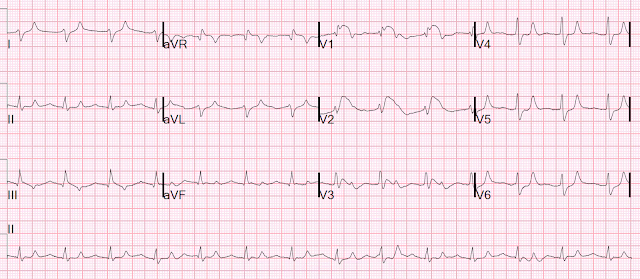I was texted this ECG:
This was my response: "Yikes. Pacer and Cath Lab!!"
He asked: "Could this all be due to hyperK?"
I said: "Always possible. But it does not look like it. Among the reasons I do not think it is all due to potassium is that the QRS is not wide." Also, there are obvious signs of OMI, and though these can sometimes be mimicked by hyperkalemia, the K must be very high.
ECG analysis: Sinus tachycardia with third degree AV block and a junctional escape. QRS is 100 ms. There are inferior Q-waves with inferior ST Elevation of OMI, and T-wave inversion, suggesting reperfusion or subacute OMI. The inverted T-waves are large, which is evidence of significant viable myocardium. The lead reciprocal to lead III is aVL, and there is the obligatory reciprocal ST depression, but also a reciprocally large upright T-wave (a mirror image to the inferior inverted (reperfusion) T-wave. There is also STD in V2 and V3, with large upright T-waves indicating reperfusion of the posterior wall. There is STE of OMI in V5 and V6, with terminal T-wave inversion, also suggestive of subacute or reperfusing lateral OMI.
The tall upright T-waves in aVL and V3 might conjure up hyperK in your mind, but these T-waves are reciprocal to large inverted reperfusion T-waves: aVL reciprocal to III, and V3 is a posterior reperfusion T-wave, reciprocal to an imaginary inverted T-wave of the posterior wall.
See my article on posterior reperfusion T-waves. Posterior reperfusion T-waves: Wellens' syndrome of the posterior wall
Comment: Heart block with junctional escape is typical of inferior infarctions. The RCA supplies the AV node. The escape in LAD occlusion is below the AV node because if results in ischemia of the bundle of His and Purkinje fibers.
Summary: subacute, reperfusing inferior, posterior, and lateral OMI with complete AV block
The clinical story came later:
It turns out that this patient presented with several days of vomiting, diarrhea, and syncope. He denied any chest pain or SOB. His vital signs were normal except for some bradycardia.
He had had a prehospital ECG:
On further evaluation, he was in DKA, with glucose of 904 and K of 5.8. They got the K down to 4.8 and repeated the ECG:
Before the patient left for the cath lab, the initial troponin I returned at 31,000 ng/L (very high, a level only seen in OMI, and an initial one this high is only seen in subacute OMI). So this is a subacute OMI.
Angiographic findings:
1. Left main: no stenosis.
2. LAD: type II, luminal irregularities, no stenosis. It supplies a D1 without stenosis.
3. Ramus intermedius: luminal irregularities, no stenosis.
4. LCX: non-dominant, supplies a small caliber OM that has an 80% stenosis (TIMI III flow).
5. RCA: dominant. Supplies an RPDA and at least 2 RPDAs. It is thrombotically occluded in the proximal segment.
Comment: The ECG shows evidence of reperfusion.
I do wonder if:
1) the artery re-occluded between the last ECG and the angiogram, or if
2) collateral circulation developed before the ECGs were recorded.
Formal Echo:
Normal left ventricular size.
The estimated left ventricular ejection fraction is 55%.
Regional wall motion abnormality:
-mid and basal inferior, akinetic. (this is the posterior wall)
-basal inferoposeptum, akinetic.
-basal inferolateral, akinetic.
Translation: inferior, lateral, and posterior OMI
Learning Point:
1. If hyperK is causing a PseudoSTEMI or PseudoOMI pattern, it will ALWAYS also cause a wide QRS.
2. If hyperK is causing a PseudoSTEMI or PseudoOMI pattern, the K will virtually always be above 7.0
Below are a number of cases of OMI mimics (PseudoSTEMI) due to severe hyperkalemia. All had K of at least 7.0 mEq/L.












No comments:
Post a Comment
DEAR READER: I have loved receiving your comments, but I am no longer able to moderate them. Since the vast majority are SPAM, I need to moderate them all. Therefore, comments will rarely be published any more. So Sorry.